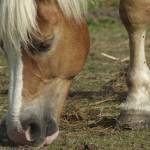Laminitis in Horses Is Nothing New

Horses that break into the feed room and gorge on grain; equines that eat too much fresh spring grass; chubby ponies that seem to get sore feet for no particular reason. Modern horse owners tend to think that laminitis is a disease linked specifically to today’s rich grain diets, abundant pasture growth, or the prevalence of equine metabolic syndrome. Though these factors can all cause laminitis, there is evidence that the crippling and painful disease has affected non-domesticated equines throughout much of their history.
In a study of coffin bone fossils dating back more than three million years, Lane Wallett, a PhD candidate at the University of Florida, looked at over a thousand specimens and found numerous signs consistent with chronic laminitis. Three-fourths of the fossils showed changes in the bone shape, density, or level of blood supply that indicated some degree of laminitis in these wild horses from past eons. This suggests that even horses in a natural setting may be at risk for laminitis, though they do not have the dietary modifications that modern horses endure.
To minimize the chance of laminitis, horse owners should follow management practices such as keeping horses at a healthy weight, limiting grain meals unless the horse needs extra calories for performance or growth, and restricting pasture access for horses sensitive to the sugars in fresh grass. Because no horse is guaranteed safe from laminitis, owners should immediately check with a veterinarian if horses show signs like lameness, heat in the hooves, or reluctance to move.








